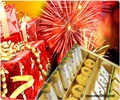Diwali, the festival of lights, is the time when fireworks companies and the Indian potters come together to brighten up one of the darkest autumn night skies. It’s the time to Be Indian, Buy Indian.

So, does switching on the tube lights, bulbs and the colourful imported fancy serial lights justify the purpose? After all, they too, dispel darkness.
Lighting up the traditional Indian lamp or diya has a deeper meaning. The ghee or oil used in the lamp stands for our negative tendencies and the wick is the ego. When the diya is lit by the flame of knowledge, there is a slow, but sure, burning of these negative tendencies and ego.
However, the current trend reveals yet another reason to light up the traditional lamp. The aftermaths of Diwali during the past few years have seen cases of burns and bruises, and people worrying about their health for having gone easy with sweets. Leading newspapers have published the dark Diwalis of the Indian potters and firework companies facing stiff competition with cheap, imported serial lamps and dangerous, illegally imported fireworks. These stories are a wake-up call for us to do something about it.
There have been several reasons cited by the buyers, sellers and the users why people should opt to use electric lights instead of the earthen oil lamps. The serial lights are cheaper and require lesser effort to light them up. Further, even after lighting, the oil lamps are blown off by wind or a small shower. The oil needs to be refilled every now and then. The serial lights are a spectacular sight as they come in various shapes, colours and designs. The dancing-musical lights that seem to be moving or changing colours are very attractive, but come at a slightly higher price.
What has the Indian government done about it?
• Plans to encourage people to use more diyas instead of cheap electric lights.
These changes have been welcomed by the fireworks manufacturers, adding that the imported crackers are also not tested for safety and could pose a threat to life. These changes also go with the Indian Prime Minister Narendra Damodardas Modi’s “Make In India” concept, in which the products bought by Indians must be made in India.
Since October 2010, newspapers have been reporting the dark Diwalis of the potters and Indian firecracker industry. The rising costs of clay, oil and ghee have seemed to contribute to the low sales of the earthen lamps. About 50-odd potter families in Rajasthan were hit badly after they worked hard to make the diyas, hoping to sell them during Diwali.
About 5 lakh families in Tamil Nadu’s Sivakasi town working in fireworks companies are threatened of getting swamped by Chinese firecrackers, as reported in October 2014. Nearly 35% of products made in India for this year’s Diwali remain unsold, posing a threat to the Rs. 60 billion Indian firecracker industry. Most of these imported firecrackers are illegal.
However, in November 2013, there was some reassuring news about the potters and sellers Patna. The report mentioned that after an ‘electrical Diwali’ the previous year, people have turned back to the soft flame of traditional diyas and the potters happily churned out a huge number of basic as well as designer earthen diyas.
So, how do we bring cheer to the Indian industry this Diwali? There is always the middle path to choose, in a way that will not hit the Indian diya and fireworks companies.
• Line up the earthen diyas and place the serial lights in them to make them look like lighted lamps.
• Use diyas that come along with wind-guards. Most of the diyas are available with the wind-shield to keep them burning against the breeze.
• Make holes in earthen pots and light a diya inside it. This will also create a light-patterns dancing on the walls of your house.
• Make designer paper lamps and light up a bulb or diya.
• Buy and use firecrackers that are made in India. Have a safe Diwali.
Let us all celebrate this Diwali as Indians – Be Indian, Buy Indian and Make In India.
Source-Medindia








